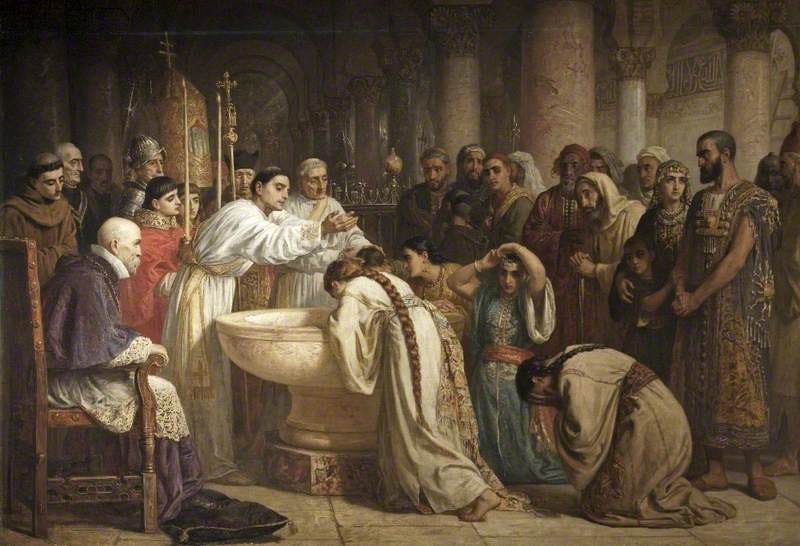Today in European history: the first Alpujarras Rebellion begins (1499)
A revolt by Granada's mistreated Muslims leads to the expulsion of all Muslims from the Iberian Peninsula.
If you’re interested in history and foreign affairs, Foreign Exchanges is the newsletter for you! Sign up for free today for regular updates on international news and US foreign policy, delivered straight to your email inbox, or subscribe and unlock the full FX experience:
When the Emirate of Granada, the last Islamic political entity on the Iberian peninsula, surrendered to the combined forces of Aragon and Castile in 1492, it did so under the terms of the Treaty of Granada, drawn up the previous year. Chief among that agreement’s terms were a series of guarantees for the emirate’s Muslim subjects. They were to be given safe passage to North Africa or, if they chose to stay, would be entitled to keep their property and their faith, to be governed according to Islamic law, and other concessions to religious tolerance. In short, they—as well as the other Muslim residents of the proto-Spanish kingdom—were allowed to go on being Muslim and promised little interference from their Christian sovereigns.
Of course this state of affairs didn’t last. There was no chance it would. But for a few years it did hold, with Spanish authorities figuring that people would be more inclined toward a genuine conversion to Christianity if they were treated well than if they were forced or coerced into converting. Flies, honey, vinegar, etc. Ferdinand and Isabella busied themselves doing terrible things to their Jewish subjects instead, starting with the Alhambra Decree of 1492, which gave them a choice between conversion and expulsion. Most opted to convert, which was probably what the authorities preferred. But Muslims, by contrast, were mostly left to their own devices.
This all changed in the summer of 1499 and the arrival in Granada of Archbishop Francisco Jiménez de Cisneros of Toledo and the office of the Spanish Inquisition. Cisneros was very conservative—he’d later serve as Grand Inquisitor for Castile and León, if that helps—and wasn’t a fan of Granadan Archbishop Hernando de Talavera’s tolerance of Muslims. Where Talavera preached to Granadan Muslims to encourage conversion, Cisneros preferred a more direct approach. He collected and burned every piece of Arabic writing he could find in the city and began tossing Muslims in jail until they agreed to convert. He was especially interested in jailing former Christians who had converted to Islam, and especially especially interested in jailing former Christian women who had converted to Islam to marry Muslim men.

Needless to say, what Cisneros was doing completely violated the terms of the Treaty of Granada, and his impetus to target the wives of Muslim men only made things more problematic. Indeed, it was one such woman, carted away by the authorities on December 18, who lit the spark for rebellion by loudly and very publicly letting people know that she was being carted off to be forcibly converted. A crowd gathered and eventually killed the constable who was trying to arrest her.
Following this incident, Granada’s Muslim quarter fell into open revolt, though this calmed down several days later. In the meantime, though, the revolt spread outside the city and into the countryside, especially into the nearby Alpujarras region, where residents were less appreciative of Christian rule in general. Ferdinand led tens of thousands of men into the region and, though it took a little over a year, had little trouble putting down the revolt. When it ended in January 1501, Ferdinand presented the surrendering rebels with conversion/expulsion choice he’d given his Jewish subjects several years before. Many left but most, unable to afford the cost of obtaining passage abroad, converted.
I mentioned above that Cisneros eventually got a promotion to Grand Inquisitor (and cardinal, while we’re on the subject), but when the revolt first broke out his future didn’t look so bright. In fact he was summoned to Seville to appear before Ferdinand and explain himself. Cisneros managed to talk himself out of trouble, convince Ferdinand that it was the Muslims who violated the treaty, and even talked himself into a new role as Queen Isabella’s personal confessor—replacing Talavera. No doubt with Cisneros advising him, Ferdinand tore up the Treaty of Granada and extended his “convert or leave” choice first to the remaining Muslims in Granada, then to all the Muslims left in Iberia.
Many of those who “converted,” who became known as Moriscos, only did so for show and privately continued to practice Islam. Spanish monarchs would spend the next century or so trying to stamp out their (real and imagined) crypto-Islamic practices, which led to more rebellions (including at least one more in the Alpujarras, in 1568). Finally, Philip III expelled the Moriscos from Spain in 1609, though many were able to dodge the expulsion and many more later returned from a brief exile.

